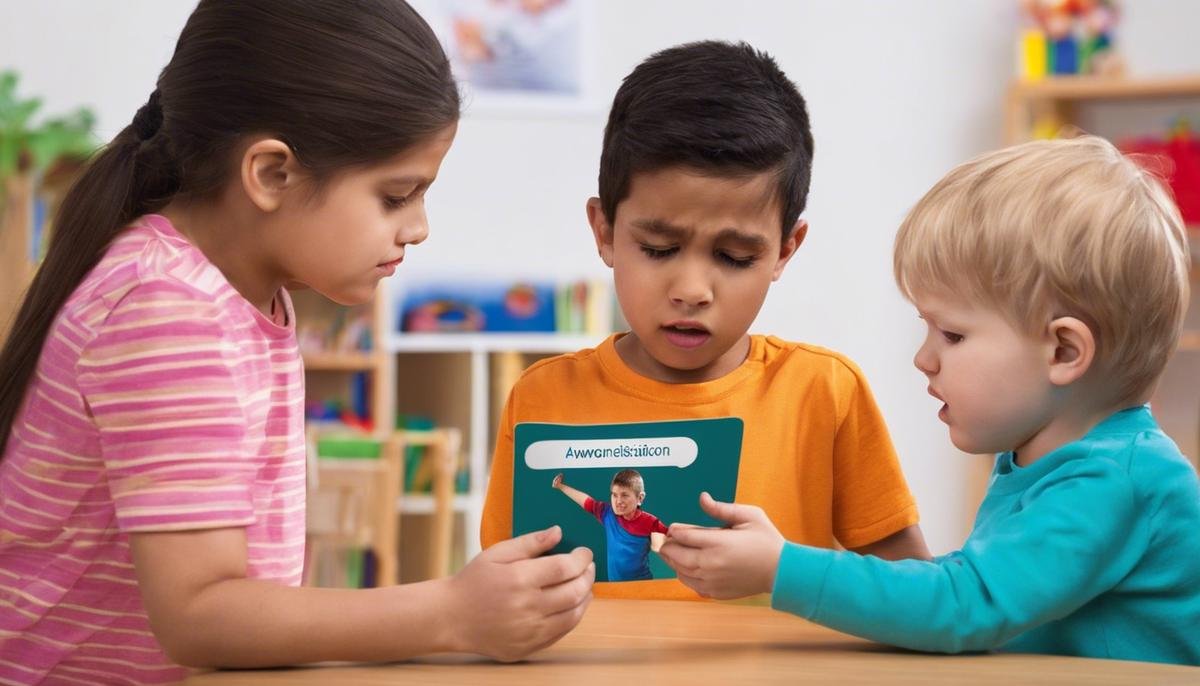
Raising a child with autism can present unique challenges, especially when faced with episodes of physical aggression. Many parents find themselves on a steep learning curve as they navigate this aspect of their child’s behavior. It’s imperative to understand the roots of aggression in autistic children, often stemming from intrinsic factors such as sensory overload, struggles with communication, or disruptions to familiar routines. By shedding light on the underlying triggers, this essay seeks to empower parents with knowledge and tools, ranging from effective communication strategies to proactive behavioral interventions, all of which aim for harmonious coexistence and personal growth. Additionally, highlighting the crucible of self-care and the realms of support systems, it strives to offer well-rounded guidance in the multifaceted journey of parenting an autistic child.
Understanding the Triggers
Unlocking the Mystery: Understanding Physical Aggression in Autistic Children
Are you a parent or caregiver seeking to better understand why some autistic children may display physical aggression? It’s a topic that’s both sensitive and deeply important. So, grab a comfy seat, and let’s explore this together like a family gathered around the kitchen table, eager to support one another on this journey.
First and foremost, it’s key to acknowledge that autism is a broad spectrum with a range of behaviors and characteristics, and not every child will exhibit aggression. But for those that do, it often stems from an inner turmoil that can be challenging to decipher.
Communication Struggles
Communication can be a monumental hurdle for many autistic kiddos. When words fail them, and emotions run high, they might resort to physical actions to express their frustration or needs. It’s like when we, as parents, see our little ones before they’ve found their words—it’s all about reading the cues.
Sensory Overload
Imagine walking into a room where every light is too bright, every sound is amplified, and every touch is magnified. That can be a daily reality for some autistic children. Sensory overload can trigger a stress response, and sometimes, that response involves physical aggression as a plea for relief.
A Need for Routine
Children on the spectrum often find solace in predictability. When routines get disrupted, it can feel like their world has turned upside down, prompting a physical reaction. Routine acts like a warm security blanket, and when it’s pulled away, it can be very unsettling.
Feeling Misunderstood
Patience and empathy go a long way, but misunderstandings can still happen. When autistic children feel misunderstood or not listened to, they may express themselves through physical means, simply trying to make their feelings known.
Managing Physical Aggression
Approaching aggression with calmness and consistency is like planting seeds of trust. Understand that this behavior is not a choice, but a form of communication. Strategies such as identifying triggers, maintaining routines, and teaching alternative communication methods like picture cards or sign language can be the bridge to understanding.
Creating a sensory-friendly environment can also be a game-changer. Think soft lighting, quiet corners, and the freedom to take a break when the world becomes too much.
Parenting and caring for an autistic child can be as challenging as it is rewarding, and when physical aggression is part of the equation, it complicates things further. But with compassion and a commitment to understanding the unique world our children live in, we can provide a nurturing environment where they can thrive.
And let’s not forget, amidst the trials, there is immense joy and love in the beautiful diversity of our families. Here’s to nurturing, learning, and growing together!

Effective Communication Strategies
Bridging the Gap: Effective Communication Techniques to Mitigate Aggression in Children
When faced with aggressive behavior in our little ones, particularly those not on the autism spectrum, it’s essential to dig deep into our parenting toolkits and pull out the most effective communication strategies to address the root of such behavior. Every child is unique, and aggression could stem from a multitude of causes—be it frustration, inability to express themselves, or simply being overwhelmed by emotions. Here’s how honed communication can indeed make a significant difference.
The Power of Active Listening: Harnessing the power of active listening can transform interactions with your child. When aggression surfaces, our first instinct might be to assert control or demand an immediate halt to such behavior. However, stepping back and offering an ear can communicate a powerful message — that their feelings are valid and important. Through active listening, we can decipher the underlying messages in their actions and guide them to verbalize their emotions, thus reducing the need for aggressive behavior as a means of communication.
Emotion Coaching: Teaching our children to understand and label their emotions is a crucial step in empowering them to express themselves more constructively. By providing the vocabulary for feelings, children learn to swap out aggression for words, such as “I’m angry because…” or “I’m frustrated when…“. Equipping them with the ability to articulate their feelings allows them to advocate for themselves peacefully.
Consistent and Clear Boundaries: Communication isn’t just about talking; it’s also about creating a consistent framework for children to understand what’s expected of them. Aggression often happens when boundaries are crossed. By clearly communicating these boundaries and the consequences of crossing them, children are given a structured environment where they can express themselves within acceptable limits.
Collaborative Problem-Solving: Engaging children in finding solutions to what triggers their aggression can be immensely effective. Instead of solely directing them, try working together to identify the problem and brainstorm possible solutions. This approach not only validates their input but also teaches them critical thinking and the importance of collaboration.
Modeling Appropriate Behavior: Parents are their children’s first and most important role models. Demonstrating how to handle conflicts and strong emotions calmly and respectfully shows children an alternative to aggression. By communicating effectively in our own interactions, we teach by example, providing children with a blueprint for managing their emotions and interactions with others.
Recognize the Good: In the midst of focusing on correcting aggressive behavior, don’t forget to acknowledge and reinforce positive behavior. When a child chooses communication over aggression, celebrate those moments. Positive reinforcement encourages them to continue using their newly learned communication skills.
In essence, communication is not just about talking; it’s about connecting. It’s about understanding and being understood. By cultivating these techniques, a parent can help ease a child’s aggression, paving the way for a calmer, more communicative family dynamic. After all, isn’t that the beauty of parenting? We get to grow and learn together with our children, building bridges with every word and every gesture, even in the face of challenges.

Proactive Behavioral Interventions
Hey there, fantastic folks of the parenting panorama! Let’s muster up some of that inexhaustible energy for a topic near and dear to our hearts: managing the stormy seas of aggression in our kiddos. Don’t worry, you’re not navigating these waters alone. Together, we’ll tack through some tried-and-true behavioral techniques that can help calm the waters.
First up, is the power of active listening. I know, I know – in the thick of a little one’s outburst, lending an ear seems as feasible as knitting a sweater during a rollercoaster ride. But hear this out – actively listening to a child’s frustrations validates their feelings. This doesn’t mean letting unacceptable behavior slide but rather understanding the root of the storm before charting a course to calmer waters.
Next, let’s talk emotion coaching. Consider this: emotions are the native language of children. By helping them label what they’re feeling (“You seem frustrated”), we arm them with a vernacular to express themselves without resorting to the physical stuff. It’s like swapping out their boxing gloves for a microphone.
Now, onto consistent and clear boundaries. Ah, boundaries, the lighthouses guiding our little ships away from rocky shores. They may test them, but kids feel secure knowing what’s ok and what leads to choppy waters. Staying firm and consistent with expectations provides a framework for acceptable behavior, making it easier for kids to steer clear of aggression.
Collaborative problem-solving is a game-changer. Here’s a secret: children love to be heard. Sit down together and brainstorm solutions to conflicts. Not only does this build critical thinking skills, but it also teaches conflict resolution – a life vest they’ll wear for years to come.
Let’s not forget the age-old adage: Monkey see, monkey do. Modeling appropriate behavior is the equivalent of setting the cruise control on good behavior. Show them how to manage feelings and resolve conflicts without throwing hands, and you’ll see them mimic these peaceful tactics on their own voyage.
Lastly, we fly the flag of positive reinforcement. This isn’t about tossing treats at them like they’re performing seals. It’s about recognizing and celebrating the good choices they’re making. A simple “Great job sharing with your sister!” can be the gentle breeze that propels them towards kinder, gentler interactions.
Alright, beloved community, it’s time to unfurl our sails and use these techniques to guide our little ones towards peaceable horizons. Here’s to smoother sailing ahead – because even in the tumult of the occasional squall, the voyage of parenting is the grandest adventure of all. Keep those spirits high, and let’s navigate these waters together.

Self-Care for the Parent
Understanding the critical role of parental self-care is often the unsung melody in the symphony of managing a child’s aggression, especially in those with unique needs, such as autistic children. When facing a storm of outbursts or confrontations, the last thing a person might have in mind is their own wellbeing. However, taking time for self-care actually equips parents with the emotional resilience and clarity required to guide their children through challenging behaviors.
Why is parental self-care so essential, you ask?
Firstly, it ensures emotional availability. Children are incredibly perceptive and can easily pick up on parental stress or fatigue. By committing to self-care, parents safeguard their emotional resources, ensuring they can remain patient, present, and connected when their children need them the most.
Maintaining one’s physical health is just as crucial. The physical demands of caring for a child with special needs can often lead to burnout if a parent isn’t careful. Regular exercise, adequate rest, and a nourishing diet are fundamental not only for personal health but also for sustaining the energy levels necessary to provide attentive care and lead by example.
Cultivating strong mental health practices is arguably the cornerstone of self-care. Techniques like mindfulness and meditation can center a parent’s thoughts, providing a sense of calm that can greatly influence a household’s atmosphere. A calm environment is known to reduce instances of aggression in children, as they absorb and mirror the tranquil behavior exemplified by their parents.
Moreover, parents who prioritize their mental health are better equipped to handle their own emotions when faced with aggressive behavior. They can respond with thoughtfulness rather than react out of frustration, thereby modeling the very behavior they wish to see in their children.
Lastly, self-care as a parent is about setting the rich tone of self-respect and personal importance within the family. Practicing self-love teaches children the value of taking care of themselves as well. It sends a clear message that everyone’s needs, including their own, are important and worth addressing.
In essence, engaging in self-care does more than rejuvenate a weary soul—it’s a tool for teaching and reinforcing the skills and values that shape healthier, happier family life. It’s about strengthening the backbone of parental guidance so that, even in the face of aggression or challenging behaviors, the response is always rooted in love, understanding, and a well-nourished spirit.
Families will find that when parents are well-cared for, everyone reaps the benefits of stability, peace, and overall well-being. Self-care hasn’t always been given the headline in discussions about child aggression management, but it’s the quiet force charting the course toward a smoother journey for both parents and children alike.

Navigating Support Systems
Title:Embracing Self-Care: A Key to Supporting Your Autistic Child
Hey there, amazing parents!
Navigating the waters of parenting a child on the autism spectrum can certainly be a roller coaster of emotions and experiences. While we’ve covered many vital strategies for understanding and supporting our special kiddos, one often overlooked aspect is the parental self-care that’s essential for being at our best. Today, let’s explore the importance of self-care and its powerful impact on our families.
Self-care isn’t just bubble baths and an occasional night out (though those are great!). It’s about ensuring that parents stay emotionally available and resilient. Remember, our emotional state sets the weather in our home. When we’re run down, stressed, or on edge, our children sense that, which can increase their anxiety and possibly lead to more challenging behaviors. By prioritizing our emotional well-being, we model healthy coping mechanisms, and our kids reap the benefits of a calmer, more nurturing environment.
Caring for a child with special needs can be physically demanding. Maintaining our own physical health is essential not only for our well-being, but it also keeps us ready to meet our child’s needs. This could mean regular exercise, a balanced diet, or just ensuring you get enough sleep. A well-rested parent is more equipped to handle the complexities of the day with a clear mind and steady hand.
Mental health practices like mindfulness and meditation might sound like buzzwords, but they’re game-changers. By incorporating these into your routine, you help cultivate a peaceful household atmosphere. This mindful approach can help in responding thoughtfully rather than reactively to aggressive behavior, fostering a calmer response from your child in the process.
When dealing with aggression or tantrums, it’s easy to get pulled into the emotional storm. Stepping back and taking care of your emotional needs helps you respond from a place of love and understanding. It’s all about handling our emotions so we can be the guiding force that our children need.
Set a tone of self-respect and personal importance within your family by making self-care a priority. It’s about showing our children that taking care of oneself is just as crucial as taking care of others. This teaches them the value of self-regulation and personal well-being.
Think of self-care as a tool not only for personal happiness but as essential for shaping healthier, happier family life. It’s the oil that keeps the family machine running smoothly. And when it comes to stability and peace within the household, a well-cared-for parent is a cornerstone.
In the quest to provide the best possible support for our children, self-care may seem secondary—but it’s actually central. It’s the foundation upon which a stable, peace-filled home is built. It might be easier to overlook self-care amidst the busy days, but it’s pivotal for our well-being and, in turn, for our children, especially when managing challenging behaviors.
In the end, remember: investing in ourselves is investing in our families. Parenthood isn’t about being perfect; it’s about being present, and the best way to be fully present is by ensuring you’re healthy—mind, body, and soul.
Stay strong, nurturing, and most importantly, well-cared-for. Our kids need us at our best, and that starts with taking care of ourselves first.
Until next time, keep on thriving!

Parenting an autistic child who may exhibit physical aggression is akin to navigating an intricate dance—one that requires patience, understanding, and continual learning. By proactively understanding and addressing triggers, honing communication skills, implementing behavioral interventions, and upholding self-care, parents can choreograph a more peaceful family dynamic. Furthermore, by effectively leveraging available support systems, caregivers can ensure they are not alone in their journey. Although each day may bring its own set of challenges, the ongoing commitment to these strategies anchors a family’s resilience, increasing the capacity for love, growth, and deep understanding between parent and child.




